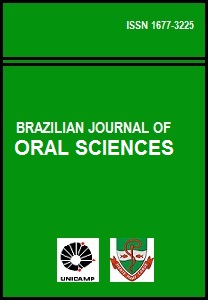Abstract
The aim of this study was to investigate the neutralizer effect of antioxidant agents on the bond strength of bleached enamel. Buccal enamel surfaces of 80 bovine incisors were divided into eight groups. The negative control group (NC) received no bleaching treatment and the other groups were bleached with 35% hydrogen peroxide gel for 30min., activated with a photocuring unit. Ten specimens were selected for the positive control group (PC) and received no anti-oxidant agents. The remaining bleached specimens received one of the six anti-oxidant agents, for 20min (10% Sodium Ascorbate–SA; Catalase–CA; Glutathione Peroxidase–GP; Acetone–AC; Ethanol–ET; 7% Sodium Bicarbonate– SB). Bonds were formed and shear bond test was carried out after 24h. The data were analyzed by one-way ANOVA and Tukey’s tests (α=5%). The PC group showed significantly lower bond strength mean than the NC group. All of the experimental groups showed bond strength means significantly lower than the NC group. The CA group showed significantly higher bond strength mean than the bleached PC group and the groups SA, GP, AC, ET and SB showed no significant differences compared to PC group. It was concluded that only the Catalase application resulted in significant increase of bond strengths in relation to the PC group and that none of the treatments was able to completely neutralize the deleterious effects of bleaching on bond strength.References
Titley KC, Torneck CD, Smith DC, Abdifar A. Adhesion of composite resin to bleached and unbleached bovine enamel. J Dent Res. 1988; 67: 1523-8.
Garcia-Godoy F, Dodge WW, Donohue M, O’Quinn JA. Composite resin bond strength after enamel bleaching. Oper Dent. 1993; 18: 144-7.
Türkün M, Kaya A.D. Effect of 10% sodium ascorbate on the shear bond strength of composite resin to bleached bovine enamel. J Oral Rehabil. 2004; 31: 1184-91.
Mcguckin RB, Thurmond BA, Osovitz S. Enamel shear bond strengths after vital bleaching. Am J Dent. 1992; 5: 216-22.
Dishman MV, Covey DA, Baughan LW. The effects of peroxide bleaching on composite to enamel bond strength. Dent Mater. 1994; 9: 33-6.
Cavalli V, Reis AF, Giannini M, Ambrosano GM. The effect of elapsed time following bleaching on enamel bond strength of resin composite. Oper Dent. 2001; 26: 597-602.
Rose RC, Bode AM. Biology of free radical scavengers: an evaluation of ascorbate. FASEB J. 1993; 7: 1135-42.
Rotstein I. Role of catalase in the elimination of residual hydrogen peroxide following tooth bleaching. J Endod. 1993; 19: 567-9.
Barghi N, Godwin JM. Reducing the adverse effect of bleaching on composite-enamel bond. J Esthet Dent. 1994; 6: 157-61.
Lai SC, Mak VF, Cheung GS, Osorio R, Toledano M, Carvalho RM et al. Reversal of Compromised Bonding to Oxidized Etched Dentin. J Dent Res. 2001; 80: 1919-24.
Lai SC, Tay FR, Cheung GS, Mak VF, Carvalho RM, Wei SH et al. Reversal of Compromised Bonding in Bleached Enamel. J Dent Res. 2002; 81: 477-81.
Titley KC, Torneck CD, Smith DC, Chernecky R, Abdifar A. Scanning electron microscopy observations on the penetration and structure of resin tags in bleached and unbleached bovine enamel. J Endod. 1991; 17: 72-5
Kalili T, Caputo AA, Mito R, Sperbeck G, Matyas J. In vitro toothbrush abrasion and bond strength of bleached enamel. Pract Period Aesthet Dent. 1991; 3: 22-4.
Sundfeld RH, Briso AL, De Sa PM, Sundfeld ML, Bedran-Russo AK. Effect of time interval between bleaching and bonding on tag formation. Bull Tokyo Dent Coll. 2005; 46: 1-6.
Titley KC, Torneck CD, Ruse ND, Krmec D. Adhesion of a resin composite to bleached and unbleached human enamel. J Endod. 1993; 19: 112-5.
Edwall L, Olgart LG. Influence of cavity washing agents on the pulpal microcirculation in the cat. Acta Odontol Scand. 1972; 30: 39-47.
Scriver CR, Beaudet AL, Sly WS, Valle D. The metabolic basis of inherited disease. 6th ed. New York: McGraw-Hill; 1989. p.1551-61, 2779-2801.
Gutteridge JM. Biological origin of free radicals, and mechanisms of anti-oxidant protection. Chem Biol Interact. 1994; 91: 133-40.
Wendel A. Glutathione peroxidase. In: Jacoby WB. Enzymatic basis of detoxification. New York: American Press; 1980, v.1, p.333-53.
Carr AC, Tijerina T, Frei B. Vitamin C protects against and reverse specific hypochlorous acid- and chloramines-dependent modifications of low-density lipoprotein. Biochem J. 2000; 2: 491-99.
Smith MJ, Anderson R. Biochemical mechanisms of hydrogen peroxide and hydpochlorous acid mediated inhibition of human mononuclear leukocyte functions in vitro: protection and reversal by anti-oxidants. Agents Actions. 1992; 36: 58-65.
VanDuijn MM, Tijssen K, VanSteveninck J, Van Der Brack PJ, Van Der Zee, J. Erythrocytes reduce extracellular ascorbate free radicals using intracellular ascorbate as an electron donor. J Biol Chem. 2000; 275: 27720-5.
Kaya AD, Turkun M. Reversal of dentin bonding to bleached teeth. Oper Dent. 2003; 28: 825-9.
Sung EC, Chan SM, Mito R, Caputo AA. Effect of carbamide peroxide bleaching on shear bond strength of composite to dental bonding agent enhanced enamel. J Prosthet Dent. 1999; 82: 595-9.
Kum KY, Lim KR, Lee CY, Park KH, Safavi KE, Fouad AF et al. Effects of removing residual peroxide and other oxygen radicals on the shear bond strengrh and failure modes at resintooth interface after tooth bleaching. Am J Dent. 2004; 17: 267-70.
Perdigão J, Francci C, Swift EJJr, Ambrose WW, Lopes M. Ultra-morfological study of the interaction of dental adhesives with carbamide peroxide-bleached enamel. Am J Dent. 1998, 11: 291-301.
Travis DF, Glimcher MJ. The structure and organization of, and the relationship between the organic matrix and the inorganic crystals of embryonic bovine enamel. J Cell Biol. 1964; 23: 447-97.
Nakamichi I, Iwaku M, Fusayama T. Bovine teeth as possible substitutes in the adhesion tests. J Dent Res. 1983; 62: 1072-81.
The Brazilian Journal of Oral Sciences uses the Creative Commons license (CC), thus preserving the integrity of the articles in an open access environment.

